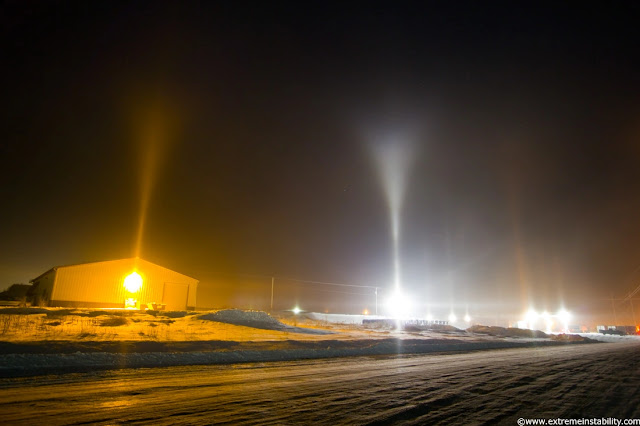Mike Hollingshead photographed these pillars on 26 January 2011 in Blair, Nebraska. The curious thing is that there are two V's above the lamp. Normally only one is seen, the upper tangent arc. While the lower V in Hollingshead's photos is the tangent arc, the upper must be the sunvex Parry arc. Or is it? Lets see if simulations are of any help. Above are two simulations made with Lars Gislen's Streetlight Halo software, which assumes omnidirectional light source. On the right is simulation with column oriented crystals, on the left with Parry oriented crystals. Light source elevation is 2 degrees. The Parry is nothing like the upper arc in Hollingshead's photos, and actually the simulations rather depict what the lower arc should look like. In the lower position Parry and tangent arcs overlap and would be indistinquishable from each other. So, not much help from simulations in identifying the upper arc. But the situation between photos and omnidirectional light simulations is not entirely comparable because even floodlighs give to some extent directed light and this why the upper arc can be seen.
Whathever the upper arc is, it is its classical form, i.e. the form that is similar to what is seen in sun light and which in divergent light situation is formed in crystals near observer. The stronger V below is the divergent light form that shows in Gislen's simulations, made by crystals further away from the observer. The upper arc could be either tangent arc or Parry arc or both, same with the lower arc. The helic arc in two of Hollingshead's images seems to indicate there is Parry population present, so perhaps Parry arc is involved in some way or another. But then again if the lamp is near 0 degrees elevation (the two degrees in the simulation may be overestimate) helic and subhelic arcs overlap, and then the halo would not be sure indication of Parry orientation, because subhelic arc forms also from column oriented crystals. Anyway, usually these displays do have Parry orientation halos and sometimes they even dominate over the column orientation halos.
Mike's photos appeared in Spaceweather.





No comments:
Post a Comment